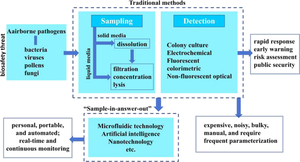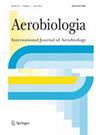On-site monitoring of airborne pathogens: recent advances in bioaerosol collection and rapid detection
Abstract
Airborne pathogens pose a great threat to public health, and their appearance in bioaerosol also increases the contiguousness due to the long survival time and transmitting range. Real-time monitoring and rapid detection methods provide more effective prevention and control of airborne pathogens. The whole procedure could be divided into bioaerosol collection and detection processes. This review presents the basic principles and recent advances in commonly used methods for each of these two steps. We categorized four different kinds of collection methods based on their principles and discussed possible enrichment methods against a small amount of targets. Four different detection methods were compared regarding their ability to perform rapid testing. In the final section, we analyzed the latest trend in combining all these steps to set up a single device or platform for rapid, automated, and continuous on-site bioaerosol monitoring to overcome time and space constraints and increase the speed of the entire monitoring process. We conclude that an integrated all-in-one system using a microfluidic platform is the most promising solution for real-time monitoring of airborne pathogens, since they are capable of simplifying operational steps, efficient collection, and high-throughput detection, demonstrating the strong potential of field-deployable platforms.
Graphical abstract


 求助内容:
求助内容: 应助结果提醒方式:
应助结果提醒方式:


